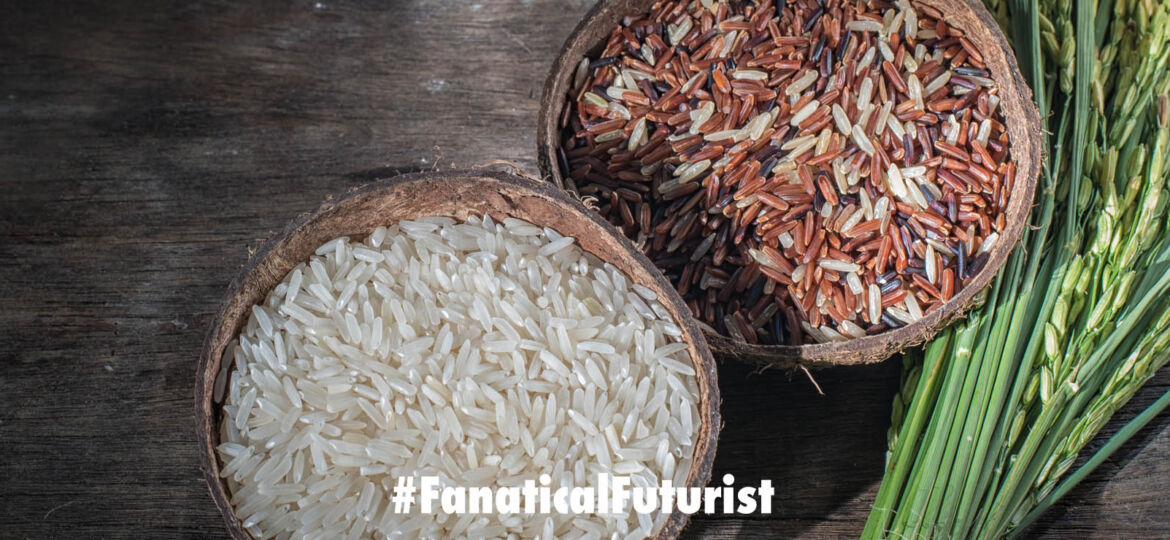
WHY THIS MATTERS IN BRIEF
Finally researchers have been able to grow a global staple crop in vertical farms and it opens the door for more and a food revolution.
 Love the Exponential Future? Join our XPotential Community, future proof yourself with courses from XPotential University, read about exponential tech and trends, connect, watch a keynote, or browse my blog.
Love the Exponential Future? Join our XPotential Community, future proof yourself with courses from XPotential University, read about exponential tech and trends, connect, watch a keynote, or browse my blog.
Growing rice the traditional paddy field way requires a lot of water and land, and is dependent on weather conditions. So, it comes as a pleasant surprise to many to find out that rice can actually be grown in Singapore – in vertical farms no less. And if you think that growing crops like rice inside in a vertical farm isn’t news worthy then it’s the first Tier 1 crop – a global staple – that’s been grown in a vertical farm ever. And that’s huge because up until now it’s all been lettuce and salads.
Grown on a wall at Block 146 Tampines Avenue 5 last week Tampines GRC Members of Parliament attended the rice harvesting ceremony at the block. The MPs threshed the rice to loosen out the rice grains from the stalks at the ceremony to signify a bountiful Year of the Tiger.
The Future of Food, by Keynote Matthew Griffin
The variant of rice grown at the vertical high-tech farm at Block 146 is the Temasek Rice.
They were created in the Temasek Life Sciences Laboratory green house before being transplanted to the vertical farm in October 2021. Prior to growing rice at the block, the laboratory conducted trials and optimised technologies to grow the rice at an experimental vertical farming structure in Lim Chu Kang.
The six-storey vertical farm at Block 146 is managed by local company Netatech, which specialises in using micro-drip technology and rainwater harvesting to reduce the resources needed to grow food crops. The farm grows rice at the top floor, while the other floors are occupied by vegetables, such as naibai and Hong Kong kai lan.
Netatech uses precision drip irrigation to water the rice and this method reduces the amount of water needed to grow rice significantly. Growing 1kg of rice in a paddy field requires 2,500 litres of water, as compared to 750 litres of water for the same amount of rice using the precision drip irrigation method, Daniel Wong, the director of technology at Netatech said.
It also takes about four months to grow each batch of Temasek rice at the Block 146 vertical farm in Tampines with the crop typically taking an additional two to four weeks to be ready for harvest.
While the rice is used for research and development purposes only for now, the vegetables grown at Block 146 are distributed to residents who gain credits to redeem these free and fresh vegetables after contributing their food waste to the black soldier fly facility at Tampines Park. A total of 165kg of vegetables are produced each month, and this can feed around 100 families of four.
The initiative at Tampines Block 146 contributes to national efforts of achieving the “30 by 30 Goal,” which is to meet 30 per cent of nutritional needs of the population by 2030 through local food production.

The vertical farm
Masagos Zulkifli, the Minister for Social and Family Development, told the media that the success of this farm has garnered interest from residents in other areas. To replicate such an infrastructure at other HDB blocks, the town council will have to ensure there is sufficient space to house such infrastructure and it will not become a form of disamentiy to the residents, such as blocking the view that they enjoy or intruding into their privacy, Masagos added.
Rice Harvest Ceremony, Singapore
Temasek rice is a semi-dwarf variety that can tolerate drought better than other rice variants. It can thrive for two weeks without water. It is also disease resistant and relatively high yield.
While Temasek rice does not taste like Thailand fragrant rice, the texture was described to be in between typical white rice and brown rice, according to Lim Hock Chuan, the Chief Executive of Temasek Foundation Liveability.
Temasek rice was grown in Indonesia and has been on sale via online supermarkets, such as Redmart and Amazon.sg, since 2016.

















[…] algunos tipos de granjas verticales pueden cultivar arroz. Hay productores en Singapur que actualmente producen arroz en granjas […]